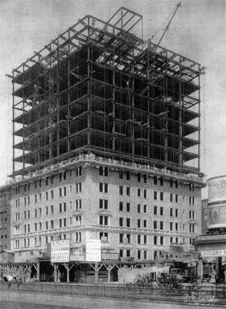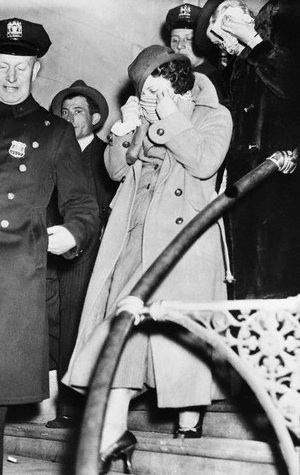The House that Polly Adler Built
She entered the brothel business without apology and set out to become the best madam in America
/https://tf-cmsv2-smithsonianmag-media.s3.amazonaws.com/filer/20120412112040polly-adler-jewish-jezebel.jpg)
Polly Adler, the most celebrated brothel keeper in New York’s (and arguably the country’s) history, proudly proclaimed her goal to become “the best…madam in all America.” For more than 20 years she ran a string of brothels throughout Manhattan, her business card—featuring a parrot on a perch—bearing an East Side exchange: LExington 2-1099. From the dawn of Prohibition through World War II, “going to Polly’s” was the preferred late-night activity for the city’s haut monde: gangsters Charles “Lucky” Luciano and Dutch Schultz, boxer Jack Dempsey, Mayor Jimmy Walker and members of the Algonquin Round Table, including Dorothy Parker and Robert Benchley, who stacked Adler’s library shelves with classic and contemporary works. “Bob was the kindest, warmest-hearted man in the world,” she said of Benchley. “He lighted up my life like the sun.” She strove to cultivate an atmosphere that was more clubhouse than cathouse, where clients were just as likely to close a business deal or hold a dinner party as retire to an upstairs boudoir. Benchley checked in for an extended stay whenever he was on deadline, always marveling that “Lion,” the house maid, had his underwear laundered and suit impeccably pressed by morning. “The Waldorf,” he told Adler, “just isn’t in it with you when it comes to service.”

Polly's calling card. From A House Is Not A Home.
Adler, like most madams, entered the profession both accidentally and tragically. She was born Pearl Adler on April 16, 1900, in Yanow, Russia, the eldest of nine children, and her earliest goal was to attend the gymnasium in Pinsk to complete the education begun by her village rabbi. Instead her father, a tailor, decided to transplant the family to America, sending them one at a time. Polly was the first to immigrate, initially living with family friends in Holyoke, Massachusetts, where she did housework and learned English. When the advent of World War I cut her off from her family—and the monthly allowance sent by her father—she moved in with cousins in Brooklyn, attending school and working in a corset factory for $5 a week. At age 17 she was raped by her foreman and became pregnant. She found a doctor who charged $150 to perform abortions, but she had only $35. The doctor took pity, accepting $25 and telling her to “take the rest and buy some shoes and stockings.”
Ostracized by her cousins, she moved to Manhattan and continued working in a factory until 1920, when her roommate introduced her to a bootlegger named Tony. He was having an affair with a prominent married woman, he confided, and needed a discreet arrangement. If Polly would take an apartment and allow him to meet her there, Tony would pay the rent. She agreed, and adopted a pragmatic philosophy about her profession she would hold throughout her life. “I am not apologizing for my decision,” Adler wrote in her memoir, “nor do I think, even if I had been aware of the moral issues involved, I would have made a different one. My feeling is that by the time there are such choices to be made, your life already has made the decision for you.”
She rented a furnished two-room apartment on Riverside Drive and began “finding” women for Tony and other acquaintances, earning $100 a week for her efforts. One evening two police officers appeared the door and escorted her to the patrol wagon on charges of being a procuress, but the case was dismissed for lack of evidence. After a brief attempt to run a lingerie shop Adler returned to prostitution, determined “not to quit until I was really heeled.” Her first step was to befriend the cops, cupping a $100 bill in her palm whenever she shook their hands; any arrest inevitably resulted in a dismissal of the case.
As her business grew the so-called “Jewish Jezebel” embarked on a series of upgrades, moving to grander apartments and updating the interiors, modeling her house—not a home, she always clarified—after the long-defunct Everleigh Club of Chicago. During the height of Prohibition her house was located inside the Majestic, at 215 West 75th Street, a building whose discreetly elegant façade hid a labyrinth of hidden stairways and secret rooms. Aside from the traditional brothel décor—gilded mirrors and oil nudes, Louis Quinze competing with Louis Seize—Adler had a few signature touches, including a Chinese Room where guests could play mah-jongg, a bar built to resemble the recently excavated King Tut’s tomb and a Gobelin tapestry depicting “Vulcan and Venus having a tender moment,” as she put it. Like her Chicago forebears, Adler treated her employees as investments rather than commodities, teaching the coarser ones table manners and encouraging them to read, reminding them that they couldn’t stay in “the life” forever. She never had to advertise or lure potential “gals,” but instead turned away thirty or forty for every one she hired.

The Majestic under construction, 1924. From www.215w75.com.
After the stock market crash of 1929, Adler feared her business would taper off, but the opposite proved true; men lined up at her door, hoping to forget their troubles, even for an hour or two. “There was an in-between period,” she recalled, “when people were trying to figure out what had hit them and estimating the extent of the damage.” But the boon was fleeting. In August 1930, the New York State Supreme Court appointed Judge Samuel Seabury to head what was—and remains—the largest investigation of municipal corruption in American history.
Adler soon received an anonymous phone call warning, “Hurry, Polly, get out of your house. They’re on their way to serve you with a subpoena.” The Seabury Commission wanted to know why Adler had never once been prosecuted for prostitution despite numerous arrests. (Under questioning, a former assistant district attorney named John C. Weston offered some insight, admitting he was “afraid of her influence” and had “laid down.”) She fled to Miami and checked into a hotel under an assumed name, following the case in the New York papers. After six months on the lam, she returned in May 1931. Two Seabury men appeared at her door the following morning, when a friend from the vice squad, Irwin O’Brien, happened to be visiting.

Polly Adler hides her face after appearing in court. From the New York Daily News.
Judge Seabury himself questioned Adler. Was it not true, he began, that Mayor Walker and other Tammany Hall politicians celebrated important events at her house? Adler responded with a series of no’s and I-don’t-recalls until the judge produced a check, holding it up for all to see. She recognized it right away as one from O’Brien; he’d given it to her as payment for some stock.
“It’s a policeman’s paycheck, is it not, Miss Adler?” Seabury asked. “And you will notice that it is endorsed with a capital ‘P.’”
“It’s not my handwriting,” Adler insisted.
“Think it over, Miss Adler. Refresh your memory, and give me your answer tomorrow.”
Several of Adler’s police contacts were convicted, although none as a result of her testimony, but she believed the investigation ultimately helped her business. “I found when I got back in business that the Seabury investigation had…made my life easier,” she wrote. “The police no longer were a headache; there was no more kowtowing to double-crossing Vice Squad men, no more hundred-dollar handshakes, no more phony raids to up the month’s quota. In fact, thanks to Judge Seabury and his not-very-merry men, I was able to operate for three years without breaking a lease.”
Adler wasn’t so fortunate during the next vice crackdown, under Walker’s successor, the reform-minded Fiorello LaGuardia. Within one minute of his swearing-in LaGuardia ordered the arrest of Lucky Luciano and followed up with a threat to the entire police department to “Drive out the racketeers or get out yourselves” and the sledgehammering of hundreds of confiscated slot machines. The new mayor was determined to scour the city free of “incorporated filth,” and in July 1936, Adler was arrested for the 16th time. She pleaded guilty to a charge of maintaining a disreputable apartment and served 24 days of a 30-day sentence at the House of Detention for Women, pitying the aging prostitutes occupying nearby cells. “The only ‘reform’ offered these women,” she wrote, “is a term in jail with bad food and harsh treatment.”
Upon her release she sought legitimate work. A friend with a factory in New Jersey worried that associating with Madam Polly would hurt his credit. A nightclub owner said she’d be the perfect business partner if only the police would leave her alone. A restaurateur was similarly apologetic when she asked to work the hat-check and cigarette concession. Resigned, Adler returned to her old profession, reasoning that “once you’re tagged as a madam it’s for keeps.” New York society frequented her house until 1943, when she moved to Burbank, California, and retired from the sex business for good. Before dying of cancer in 1962, she realized her lifelong goal of completing high school. She had taken to calling herself “madam emeritus.”
Sources:
Books: Polly Adler, A House Is Not A Home. New York: Reinhart, 1953; Alyn Brodsky, The Great Mayor: Fiorello La Guardia and the Making of the City of New York. New York: St. Martin’s Press, 2003; Herbert Mitgang, The Man Who Rode the Tiger. Philadelphia: Lippincott, 1963.
Articles: “Ex-senator John Edwards denies report he patronized hooked linked to accused Soccer Mom Madam Anna Gristina.” New York Daily News, March 23, 2012; “Charged as Madam, and Defended as Entrepreneur and Pig Rescuer.” New York Times, March 6, 2012; “Inside Madam Anna Gristina’s Upper East Side Love Lair Brothel.” New York Post, March 9, 2012; “Vice Squad Man Got Polly Adler’s Cash.” New York Times, July 23, 1931; “Polly Adler Quits Jail.” New York Times, June 3, 1935; “Find ‘Key Witness’ On Vice Graft Ring.” New York Times, May 7, 1931; “Eleven Judges Heard In Bonding Inquiry.” New York Times, March 14, 1935; “Vice Policeman Balks On Polly Adler Deals.” New York Times, August 8, 1931. “Polly Adler, 62, Dies in California.” Harford Courant, June 11, 1962; “Polly Adler Dead; Wrote A House Is Not A Home. Washington Post, June 11, 1962; “Feared ‘Influence,’ Weston Declares.” New York Times, July 14, 1931.
/https://tf-cmsv2-smithsonianmag-media.s3.amazonaws.com/accounts/headshot/karen-abbot-240.jpg)
/https://tf-cmsv2-smithsonianmag-media.s3.amazonaws.com/accounts/headshot/karen-abbot-240.jpg)